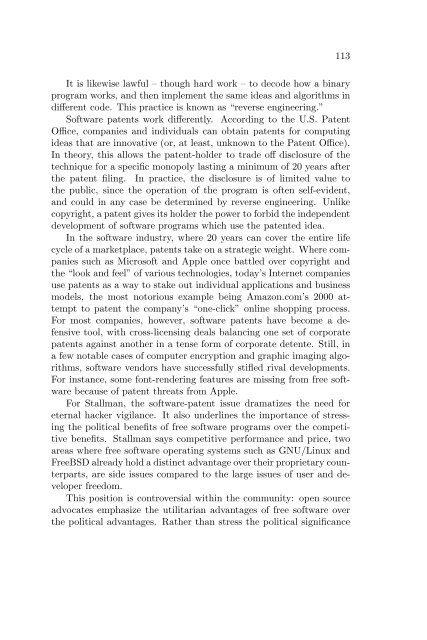You also want an ePaper? Increase the reach of your titles
YUMPU automatically turns print PDFs into web optimized ePapers that Google loves.
113<br />
It is likewise lawful – though hard work – to decode how a binary<br />
program works, and then implement the same ideas and algorithms in<br />
different code. This practice is known as “reverse engineering.”<br />
Software patents work differently. According to the U.S. Patent<br />
Office, companies and individuals can obtain patents for computing<br />
ideas that are innovative (or, at least, unknown to the Patent Office).<br />
In theory, this allows the patent-holder to trade off disclosure of the<br />
technique for a specific monopoly lasting a minimum of 20 years after<br />
the patent filing. In practice, the disclosure is of limited value to<br />
the public, since the operation of the program is often self-evident,<br />
and could in any case be determined by reverse engineering. Unlike<br />
copyright, a patent gives its holder the power to forbid the independent<br />
development of software programs which use the patented idea.<br />
In the software industry, where 20 years can cover the entire life<br />
cycle of a marketplace, patents take on a strategic weight. Where companies<br />
such as Microsoft and Apple once battled over copyright and<br />
the “look and feel” of various technologies, today’s Internet companies<br />
use patents as a way to stake out individual applications and business<br />
models, the most notorious example being Amazon.com’s 2000 attempt<br />
to patent the company’s “one-click” online shopping process.<br />
For most companies, however, software patents have become a defensive<br />
tool, with cross-licensing deals balancing one set of corporate<br />
patents against another in a tense form of corporate detente. Still, in<br />
a few notable cases of computer encryption and graphic imaging algorithms,<br />
software vendors have successfully stifled rival developments.<br />
For instance, some font-rendering features are missing from free software<br />
because of patent threats from Apple.<br />
For Stallman, the software-patent issue dramatizes the need for<br />
eternal hacker vigilance. It also underlines the importance of stressing<br />
the political benefits of free software programs over the competitive<br />
benefits. Stallman says competitive performance and price, two<br />
areas where free software operating systems such as GNU/Linux and<br />
FreeBSD already hold a distinct advantage over their proprietary counterparts,<br />
are side issues compared to the large issues of user and developer<br />
freedom.<br />
This position is controversial within the community: open source<br />
advocates emphasize the utilitarian advantages of free software over<br />
the political advantages. Rather than stress the political significance


